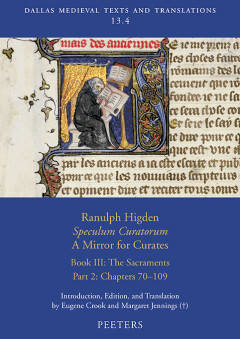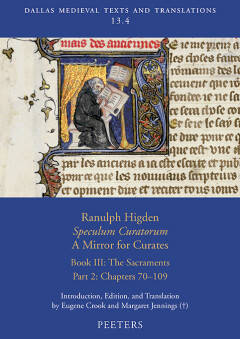
- Afhalen na 1 uur in een winkel met voorraad
- Gratis thuislevering in België vanaf € 30
- Ruim aanbod met 7 miljoen producten
- Afhalen na 1 uur in een winkel met voorraad
- Gratis thuislevering in België vanaf € 30
- Ruim aanbod met 7 miljoen producten
Zoeken
Ranulph Higden, Speculum Curatorum - A Mirror for Curates. Book III. Part 2
The Sacraments. Chapters 70-109
E Crook, M Jennings
€ 223,95
+ 447 punten
Omschrijving
Shortly after the Black Death's ravages, Ranulph Higden (ca. 1285-1364), a Benedictine monk at St. Werburg's abbey in Chester, revised his 1340 Speculum curatorum (or Mirror for Curates), a comprehensive manual for parish priests. It is now divided into three books: I: The Ten Commandments; II: The Seven Capital Sins; and III: The Sacraments. Since the plague's decimation of the parochial clergy, Benedictine monks began to fulfill the need for pastoral care; so Higden's newly revised manual addresses both the re-education of preachers in general and the new training required among his fellow monks. Here in Book III he lays the foundation for analyzing the sacraments by examining the gifts of the Holy Spirit, the beatitudes, grace and free will, as well as merit and virtue. In his examination on the sacraments, Higden interweaves theological discussion with anecdotal and hearsay materials that shed light on the everyday practices and beliefs of the Church in late medieval England. Thus, the reader learns that baptism must not be performed with beer, or that extreme unction should extend to anointing the generative organs. Although Higden characterizes his treatment of the sacraments as a "little book" (libellulus), this part of the Speculum curatorum is as lengthy as the first two combined. Clearly, the sacraments represented the culmination of pastoral care. This volume contains chapters 70-109 of Book III. These chapters deal with marriage and penance.
Specificaties
Betrokkenen
- Auteur(s):
- Uitgeverij:
Inhoud
- Aantal bladzijden:
- 461
- Taal:
- Engels
- Reeks:
Eigenschappen
- Productcode (EAN):
- 9789042952737
- Verschijningsdatum:
- 9/07/2025
- Uitvoering:
- Paperback
- Formaat:
- Trade paperback (VS)
- Afmetingen:
- 160 mm x 240 mm
- Gewicht:
- 199 g

Alleen bij Standaard Boekhandel
+ 447 punten op je klantenkaart van Standaard Boekhandel
Beoordelingen
We publiceren alleen reviews die voldoen aan de voorwaarden voor reviews. Bekijk onze voorwaarden voor reviews.








